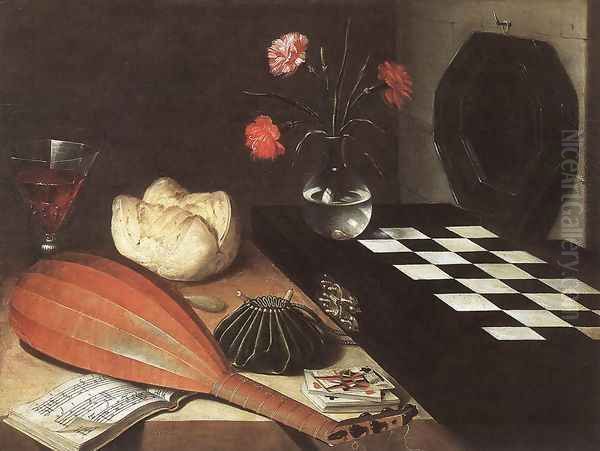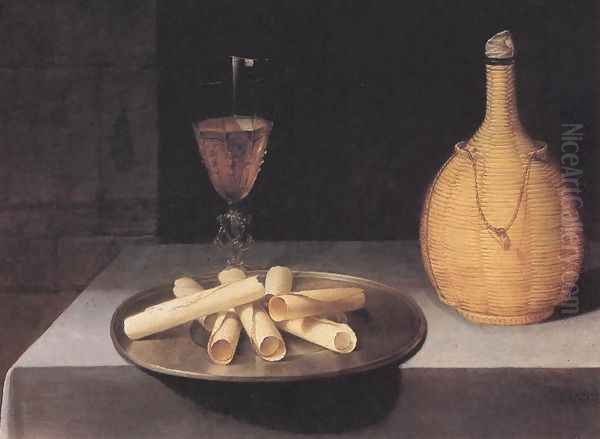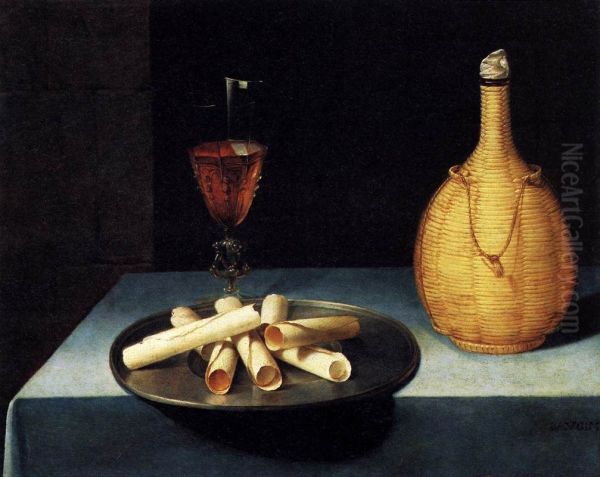Lubin Baugin stands as a fascinating, if somewhat enigmatic, figure in the rich tapestry of 17th-century French Baroque art. Active during a period of profound artistic transformation in France, Baugin distinguished himself primarily through his exquisite still lifes and his deeply felt religious compositions. His work navigates a unique path between the austere realism prevalent in some Northern European traditions and the elegant classicism influenced by Italian masters. Often overshadowed in historical accounts by grander court painters, Baugin's subtle artistry and the intriguing duality of his known oeuvre have increasingly captivated modern scholars and art enthusiasts, revealing a painter of exceptional skill and quiet depth.
Early Life and Artistic Formation in Pithiviers and Paris
Lubin Baugin is believed to have been born around 1612, though some earlier sources suggest 1610, in Pithiviers, a town in the Loiret department of north-central France. His family was reportedly well-off, which likely afforded him the means to pursue an artistic education. Details about his earliest training remain scarce, a common challenge when researching artists from this period who did not achieve immediate, widespread fame or leave extensive personal records. It is generally accepted that he received his foundational artistic instruction between 1622 and 1628.
By 1629, Baugin had made the significant move to Paris, the burgeoning artistic capital of France. In that same year, he achieved the status of a master painter within the Corporation des peintres et sculpteurs de Saint-Germain-des-Prés. This guild operated somewhat independently of the older, more established Parisian guild of Maîtrise, and it attracted a diverse group of artists, including many from outside Paris, such as Flemish and Dutch painters. This environment would have exposed Baugin to a variety of artistic currents, fostering a rich ground for his development. His early years in Paris were crucial in shaping his artistic identity, placing him at the crossroads of various stylistic influences.
The Allure of Italy: A Possible Sojourn

A persistent question in Baugin scholarship concerns a potential visit to Italy. While no definitive documentary proof, such as travel records or guild registrations in Italian cities, has surfaced, the stylistic evidence in some of his works strongly suggests an Italian sojourn, likely in the early 1630s, perhaps between 1632 and 1633. His religious paintings, in particular, exhibit a clear affinity with the Bolognese school and the classicizing tendencies of artists like Guido Reni.
Indeed, Baugin was sometimes referred to by his contemporaries or near-contemporaries as "le petit Guide" (the little Guido), a nickname that explicitly links him to the celebrated Italian master. Such a moniker would hardly have been applied without a perceived stylistic debt or a direct engagement with Reni's work, which was most accessible and impactful in Italy itself. If Baugin did travel to Italy, Rome would have been a primary destination, offering exposure not only to Reni but also to the lingering influence of Caravaggio and the works of the Carracci family – Annibale, Agostino, and Ludovico – whose academy had been pivotal in shaping the Baroque style. The classical compositions, idealized figures, and refined emotional expression found in Baugin's religious art resonate deeply with these Italian precedents.
The Enigma of Two Styles: The Austere Beauty of Still Life
One of the most intriguing aspects of Lubin Baugin's artistic output is the apparent stylistic divergence between his still lifes and his religious paintings. This has led some scholars in the past to even speculate whether "Lubin Baugin" might refer to two distinct artists. However, current consensus attributes both bodies of work to the same hand, highlighting a remarkable versatility.
His still lifes are masterpieces of quiet contemplation and meticulous realism. Works such as the celebrated Le Dessert de gaufrettes (Still Life with Wafers, also known as The Waffle Dessert), housed in the Louvre Museum, exemplify his approach. This painting, likely from the 1630s, presents a humble arrangement: a plate of rolled wafers, a glass of wine, a loaf of bread, and perhaps a pomegranate or apple, set against a dark, undefined background. The composition is deceptively simple, yet exquisitely balanced. Baugin's rendering of textures – the crispness of the wafers, the transparency of the glass, the soft sheen of the fruit – is masterful. He employs a cool, restrained palette and a subtle play of light and shadow (chiaroscuro) that imbues the objects with a palpable presence.

Another iconic still life is Still Life with Chessboard (also known as The Five Senses or Allegory of the Five Senses), also in the Louvre. This work is more complex in its iconography. It features a lute (hearing and touch), a carnation in a vase (smell), a glass of wine and bread (taste), and a chessboard with playing cards (sight, but also symbolic of life's game or vanitas). The objects are arranged with geometric precision on a wooden table, their forms clearly delineated. The atmosphere is one of profound stillness and introspection. These works share a certain austerity and a focus on the essential, reminiscent of the "bodegones" of Spanish painters like Francisco de Zurbarán or Juan Sánchez Cotán, as well as the more restrained Dutch still lifes of artists like Pieter Claesz. or Willem Claesz. Heda.
Baugin's still lifes often carry symbolic weight, aligning with the vanitas tradition prevalent in Baroque art. This tradition emphasized the transience of life, the futility of earthly pleasures, and the inevitability of death. While not as overtly laden with skulls or hourglasses as some Dutch examples, the careful selection and arrangement of objects in Baugin's paintings – the ephemeral beauty of a flower, the fleeting pleasure of wine, the game of chance – invite deeper reflection on human existence. His approach is less about ostentatious display, as seen in the pronkstillevens of Flemish artists like Frans Snyders or Dutch painters like Jan Davidsz. de Heem, and more about a meditative, almost spiritual engagement with the material world. He is often grouped with the "Peintres de la réalité" (Painters of Reality), a term coined by later art historians to describe French artists of this period who focused on direct observation and unidealized subjects, a group that also includes Georges de La Tour and the Le Nain brothers (Antoine, Louis, and Mathieu).
The Enigma of Two Styles: Religious and Mythological Compositions
Contrasting with the cool, precise realism of his still lifes, Lubin Baugin's religious and mythological paintings exhibit a softer, more idealized style, often characterized by graceful figures, flowing drapery, and a warmer, more varied palette. These works clearly demonstrate the impact of Italian art, particularly the classicism of the Bolognese school.
Works such as The Holy Family with the Infant Saint John the Baptist, The Dead Christ Mourned by Two Angels, or The Childhood of Jupiter showcase this aspect of his art. The figures are often elegant and imbued with a gentle pathos. His compositions are balanced and harmonious, reflecting the classical ideals revived during the Renaissance and carried into the Baroque period by artists like Guido Reni, Domenichino, and even the more classical side of Simon Vouet, who had returned to Paris from Italy in 1627 and became a dominant force in French painting.

The influence of Reni is particularly palpable in the sweet expressions, delicate modeling of flesh, and the serene, almost ethereal quality of some of Baugin's religious figures. This earned him the aforementioned nickname "le petit Guide." There's a tenderness and a refined emotionality in these works that differs markedly from the stark objectivity of his still lifes. Some scholars also detect echoes of the Fontainebleau School's Mannerist elegance, particularly in the elongated proportions and graceful poses of certain figures, a legacy that lingered in French art. The Fontainebleau artists, such as Rosso Fiorentino and Francesco Primaticcio, had established a sophisticated courtly style in the 16th century.
The stylistic duality in Baugin's work – the meticulous, almost severe realism of the still lifes versus the graceful idealism of the religious scenes – remains a subject of discussion. It could reflect a conscious adaptation of style to subject matter, a common practice among versatile artists. Alternatively, it might indicate different phases in his career or responses to different types of patronage. The still lifes, with their intimate scale and introspective mood, might have appealed to private collectors, while the religious paintings were likely destined for churches or devotional settings.
The Académie Royale and Later Career
Lubin Baugin's career continued to develop in Paris. A significant milestone was his admission to the prestigious Académie Royale de Peinture et de Sculpture in 1651. Founded in 1648 under the patronage of King Louis XIV, the Académie aimed to elevate the status of artists, provide structured training, and promote a distinctly French national style, often favoring history painting in the "grand manner" as exemplified by artists like Nicolas Poussin and later Charles Le Brun. Baugin's acceptance into this institution indicates his recognized standing within the Parisian art world.
His later religious works continued to show his engagement with Italianate classicism, but perhaps with an increasing French sensibility for clarity and decorum. He seems to have maintained a steady production of religious paintings, which were in demand for churches and private chapels during the Counter-Reformation period, which emphasized the power of art to inspire piety.
Despite his membership in the Académie and his evident skill, Baugin never achieved the level of fame or courtly patronage enjoyed by some of his contemporaries like Simon Vouet, Eustache Le Sueur, or Charles Le Brun, who would come to dominate French art under Louis XIV. Baugin's temperament, as suggested by his still lifes, might have been more inclined towards quiet introspection than grand public statements.

Information about his personal life remains limited. There are suggestions he may have married in Rome and had children, but these details are not firmly substantiated. Lubin Baugin passed away in Paris on July 11, 1663, at a relatively young age, likely around 50 or 51. His death occurred before the full consolidation of academic art under Le Brun, leaving his legacy somewhat in the shadows for a considerable time.
Artistic Influences and Contemporaries: A Rich Milieu
Lubin Baugin operated within a vibrant and diverse artistic milieu. His work reflects an awareness of and engagement with several key artistic currents and influential figures:
Italian Masters: As discussed, Guido Reni was a paramount influence, particularly for his religious works. The broader impact of the Bolognese school, including Annibale Carracci and Domenichino, is also evident. The dramatic realism and tenebrism of Caravaggio, though perhaps filtered through French interpreters like Valentin de Boulogne or Georges de La Tour, may also have played a role in shaping the strong contrasts in some of his works.
French Contemporaries:
Simon Vouet: A leading figure in introducing the Italian Baroque style to France. Baugin may have collaborated with him or at least been significantly influenced by Vouet's elegant and decorative compositions after Vouet's return to Paris.
Nicolas Poussin and Claude Lorrain: While Baugin's style differs, Poussin (based in Rome) and Lorrain represented the pinnacle of French classicism in historical/mythological painting and idealized landscape, respectively. Their emphasis on order, harmony, and intellectual rigor set a high bar for French art.
Georges de La Tour: A master of chiaroscuro, known for his candlelit religious and genre scenes. La Tour, like Baugin, is considered one of the "Peintres de la réalité," and though their styles are distinct, they shared an interest in profound human experiences rendered with striking realism.
The Le Nain Brothers (Antoine, Louis, Mathieu): Famous for their dignified and empathetic depictions of peasant life, they too are key figures among the "Peintres de la réalité."
Philippe de Champaigne: A Franco-Flemish painter known for his austere portraits and religious works, often associated with Jansenism. His sober realism and psychological depth offer another point of comparison within French art of the period.
Other Still Life Painters: Baugin was not alone in practicing still life in France. Artists like Jacques Linard and Louise Moillon were also creating exquisite still lifes, often focusing on fruits and flowers, contributing to a distinct French tradition in the genre that was less opulent than its Flemish counterparts but no less refined. Sébastien Stoskopff, an Alsatian painter active in Paris, was another significant still life specialist known for his intricate compositions and trompe-l'oeil effects.
Flemish and Dutch Influences:
The general tradition of Northern European still life painting, with its meticulous detail and symbolic content, clearly informed Baugin's approach. Artists like Pieter Claesz., Willem Claesz. Heda (Dutch "monochromatic banquet pieces"), Osias Beert, and Clara Peeters (Flemish pioneers of still life) established conventions that resonated across Europe.
While Baugin's still lifes are more restrained, the broader Flemish Baroque exuberance of Peter Paul Rubens and Anthony van Dyck set a dynamic tone for the era, though their direct influence on Baugin is less apparent than that of Italian classicism or Northern still life specialists.
Fontainebleau School: The legacy of this earlier French Renaissance movement, with its elegant Mannerist forms, continued to exert a subtle influence on French artists, perhaps visible in the graceful figural types in some of Baugin's religious works.
Legacy and Rediscovery
For centuries after his death, Lubin Baugin remained a relatively obscure figure in art history. His limited signed works and the stylistic dichotomy of his oeuvre contributed to this neglect. Many of his paintings were likely misattributed or simply cataloged as anonymous. The grand narrative of French art often focused on the more prominent academic painters or those directly associated with royal patronage.
However, the late 19th and 20th centuries saw a renewed interest in the "Peintres de la réalité" and a broader re-evaluation of Baroque art beyond its most famous names. Art historians, notably Charles Sterling, played a crucial role in reconstructing Baugin's catalogue raisonné and highlighting his unique contributions. His still lifes, in particular, resonated with modern sensibilities due to their formal purity, quiet intensity, and psychological depth. The enigmatic quality of his art, poised between tangible reality and spiritual suggestion, continues to fascinলাইনে.
Today, Lubin Baugin is recognized as a significant master of French Baroque painting. His still lifes are considered among the finest examples of the genre produced in 17th-century France, admired for their technical perfection, subtle poetry, and intellectual rigor. His religious paintings, while perhaps less consistently striking to modern eyes than his still lifes, demonstrate his versatility and his deep engagement with the classical tradition. The Louvre Museum in Paris holds key examples of his work, ensuring his accessibility to a global audience. Other museums in France and internationally also possess paintings by him, allowing for a fuller appreciation of his talent.
Conclusion: A Painter of Quiet Distinction
Lubin Baugin's art offers a compelling window into the complexities of 17th-century French painting. He masterfully navigated the diverse artistic currents of his time, absorbing influences from Italy and Northern Europe while forging a distinctive personal style. His still lifes, with their austere beauty and profound symbolism, invite quiet contemplation and reveal an artist acutely sensitive to the visual and spiritual qualities of the everyday world. His religious works, marked by their classical grace and tender emotion, demonstrate his ability to engage with the grand themes of faith with sincerity and skill.
The "enigma" of Lubin Baugin – the stylistic duality, the limited biographical information, the long period of obscurity – only adds to his allure. He remains a testament to the fact that artistic significance is not always measured by contemporary fame or voluminous output. In his carefully crafted compositions, Lubin Baugin achieved a timeless quality, a quiet distinction that continues to speak to viewers centuries later, securing his place as a subtle but important master of the French Baroque. His legacy is one of refined craftsmanship, intellectual depth, and a unique artistic vision that bridged the tangible and the transcendent.